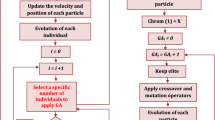Abstract
Injection molding process parameters such as injection temperature, mold temperature, and injection time have direct influence on the quality and cost of products. However, the optimization of these parameters is a complex and difficult task. In this paper, a novel surrogate-based evolutionary algorithm for process parameters optimization is proposed. Considering that most injection molded parts have a sheet like geometry, a fast strip analysis model is adopted as a surrogate model to approximate the time-consuming computer simulation software for predicating the filling characteristics of injection molding, in which the original part is represented by a rectangular strip, and a finite difference method is adopted to solve one dimensional flow in the strip. Having established the surrogate model, a particle swarm optimization algorithm is employed to find out the optimum process parameters over a space of all feasible process parameters. Case studies show that the proposed optimization algorithm can optimize the process parameters effectively.
Similar content being viewed by others
References
Deng YM, Lam YC, Britton GA (2004) Optimization of injection moulding conditions with user-definable objective functions based on a genetic algorithm. Int J Prod Res 42:1365–1390. doi:10.1080/00207540310001632475
Kumar A, Ghoshdatidar PS, Muju MK (2002) Computer simulation of transport processes during injection mold-filling and optimization of the molding conditions. J Mater Process Technol 120:438–449. doi:10.1016/S0924-0136(01)01211-0
Pandelidis I, Zou Q (1990) Optimization of injection molding design part II: molding conditions optimization. Polym Eng Sci 30:883–892. doi:10.1002/pen.760301503
Shi F, Lou ZL, Lu JG, Zhang YQ (2003) Optimisation of plastic injection molding process with soft computing. Int J Adv Manuf Technol 21:656–661. doi:10.1007/s00170-002-1374-3
Lam YC, Britton GA, Deng YM (2003) A computer-aided system for an optimal moulding conditions design using a simulation-based approach. Int J Adv Manuf Technol 22:574–586. doi:10.1007/s00170-003-1558-5
Mok SL, Kwong CK, Lau WS (1999) Review of research in the determination of process parameters for plastic injection molding. Adv Polym Technol 18:225–236
Kurtaran H, Erzurumlu T (2006) Efficient warpage optimization of thin shell plastic parts using response surface methodology and genetic algorithm. Int J Adv Manuf Technol 27:468–472. doi:10.1007/s00170-004-2321-2
Shen CY, Wang LX, Li Q (2007) Optimization of injection molding process parameters using combination of artificial neural network and genetic algorithm method. J Mater Process Technol 183:412–418. doi:10.1016/j.jmatprotec.2006.10.036
Chen WC, Tai PH, Wang MW, Deng WJ, Chen CT (2008) A neural network-based approach for dynamic quality prediction in a plastic injection molding process. Expert Syst Appl 35:843–849. doi:10.1016/j.eswa.2007.07.037
Zhou J, Turng LS, Kramschuster A (2006) Single and multi objective optimization for injection molding using numerical simulation with surrogate models and genetic algorithms. Int Polym Process 21:509–520
Gao YH, Wang XC (2009) Surrogate-based process optimization for reducing warpage in injection molding. J Mater Process Technol 209:1302–1309. doi:10.1016/j.jmatprotec.2008.03.048
Zhou J, Turng LS (2007) Process optimization of injection molding using an adaptive surrogate model with Gaussian process approach. Polym Eng Sci 47:684–694. doi:10.1002/pen.20741
Zhou HM, Li DQ (2006) Integrated simulation of the injection molding process with stereolithography molds. Int J Adv Manuf Technol 28:53–60. doi:10.1007/s00170-004-2327-9
Ballman R, Shusman T (1959) Easy way to calculate injection molding set-up time. Mod Plast 37:126
Kennedy J, Eberhart RC (1995) Particle swarm optimization. IEEE International Conference on Neural Networks, Perth, Australia, pp 1942–1948
Poli R, Kennedy J, Blackwell T (2007) Particle swarm optimization: an overview. Swarm Intell 1:33–57. doi:10.1007/s11721-007-0002-0
Author information
Authors and Affiliations
Corresponding author
Rights and permissions
About this article
Cite this article
Zhao, P., Zhou, H., Li, Y. et al. Process parameters optimization of injection molding using a fast strip analysis as a surrogate model. Int J Adv Manuf Technol 49, 949–959 (2010). https://doi.org/10.1007/s00170-009-2435-7
Received:
Accepted:
Published:
Issue Date:
DOI: https://doi.org/10.1007/s00170-009-2435-7




